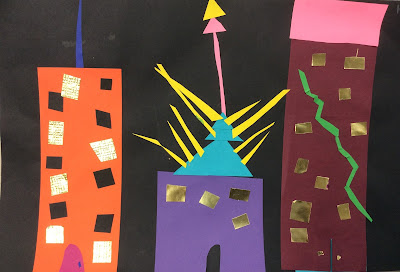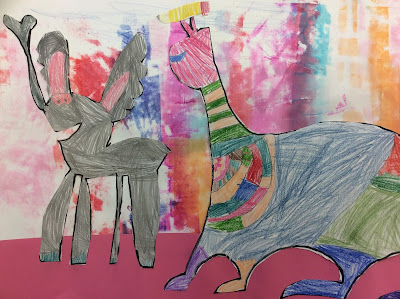As artists moved into using cut paper to create their own cities, they asked themselves questions such as: What types of buildings are these? How are they used? Do people live in them, work in them, store things in them?
Students identified many similarities in the buildings we studied. Most have windows, all have some type of door or entrance, all have a roof of some kind. Students noticed that you could count the windows going upward and guess at how many floors a building has.
They noted differences as well- some were tall and decorative, some small and plain, some with roof lines or architectural shapes that suggested that the building might be in a different country.
 |
| The roofs of these! |
Students discussed how to tell if there was someone inside ("The lights would be on.") and how to tell if you would be welcome in also ("The door could be open.").
We discussed how architects make our building safe, adding details such as lightning rods or fire escape ladders.
When the buildings were complete students experimented with using a large nail (instead of a paintbrush) to add objects to their night skies. The sharp point allowed artists to create tiny pinpricks of light, or to drag a little paint puddle in several directions to create stars, meteors, and more.
Window sills, large arches over doorways, and chimneys adorn the building students made, all while further sharpening their fine motor skills through careful cutting and gluing.
Which leads me to one more thought: whenever you have time at home with your children- maybe over this upcoming vacation- take a few minutes to do an activity that helps them build strength and dexterity in their hands and fingers. As you can read in this excellent and to-the-point article, many children are not spending enough time refining their grips (on pencils, on scissors) which can leave them profoundly behind peers when it comes time to learn to write. They need practice, practice, practice to learn to hold an art or writing implement the right way. Consider taking a few minutes over vacation to write and color a letter to a loved one, to cut pictures out of magazines to make a simple collage, or to let them roll out the pie dough on their own.
Have a happy, messy, and creative vacation!



































